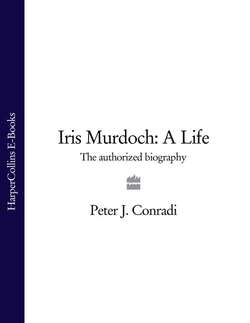Читать книгу Iris Murdoch: A Life: The Authorized Biography - Peter Conradi J. - Страница 22
4
ОглавлениеFrench was taught by Mme Barbier, a mild little elderly Frenchwoman with her hair in a ‘bird’s nest’ bun on top of her head, wearing the purple ribbon of the Légion d’Honneur. History began as stories, starting with Blakie’s Britain and her Neigbours, and moving on to Marten and Carter’s (1930).23 Greek and Roman history were taught with a merging of history and literature. There were also lessons on the Greek myths and Nordic folklore. Grammar lessons were formal, so was spelling. Miss Burdett would read poetry soulfully –? filigree petal!’24 Miss Bain’s lessons to older pupils, known as ‘Affairs’, brought them into contact with the League of Nations Union, with at least one (boring) lecture by a founder, Dr Gooch. Iris’s next school, Badminton, was to deepen this connexion, and her first trip abroad, in 1935, would be to the League’s Summer School in Geneva. Economics involved making ‘cheque-books’, running a ‘bank’, buying and selling ‘shares’. In September 1931 there was a talk about going off the Gold Standard. The pupils also joined ‘The Men of the Trees’, founded by Richard St Barbe Baker, the earliest ‘green movement’.
There were imaginative visits. The children were taken to the Surrey Docks to visit the SS Alaunia, a P & O ship on the Australia line. When it sailed they followed its progress through the ‘Shipping News’ which then appeared daily in the newspapers, receiving a lesson on each port of call, then inventing a letter home as if they had been passengers calling at Gibraltar, Port Said, Colombo. They visited the Bryant & May match factory at Silvertown in the East End, saw fir trees reduced to matchwood by huge screaming saws, were awed by the vats of bubbling chemicals. They visited Walter de la Mare, in Bayswater, and met the tiny poet, who told them a story about a fly.25
A girl who did well amassed a cluster of red stars, each denoting an ‘excellent’ mark. Some stuck these on the timetable pinned to the inside lid of their desk.26 By 1931–32 Iris was doing so well as to be head girl – ‘a Botticelli angel’ with straight bobbed blonde hair.27 Barbara Denny was in awe of Iris: she was ‘so good, so beautiful, and so intelligent and so nice’ that Barbara, who was to succeed her as head girl, did not dare speak to her. Iris had the job of ringing the bell in the corridor for everyone to calm down and progress into the Main Hall for prayers.28
‘Prayers’ were idiosyncratic. ‘Jesus: my first (and last?) Jewish boy,’ Iris was to note later,29 but it is not clear how much Froebel was responsible for introducing her to that first Jewish boy. The children took their places not in conventional class rows but in concentric circles, referred to by Miss Bain as ‘a symbol of our one-ness’,30 the oldest against the walls on fixed benches, the others sitting cross-legged in diminishing circles to the babies in the centre who were supposed to be holding hands, though some waved to watching Mamas in the gallery above. There was a hymn, perhaps a psalm, finally a doxology such as ‘God be in my Head’, ‘Glad that I live am I’, ‘Lord God in Paradise look upon our Sowing’, ‘Lead me’ and ‘The Year’s at the Spring’. Entering and leaving the hall was accompanied by the music mistress Miss Catherine Tosh to tunes such as Grieg’s Homage March. The choice of hymns, probably from a hymnal called Laudate, may have reflected Miss Bain’s Unitarianism, with hymns orientated towards God the Father rather than the Son.
The English teacher Miss Burdett – rather formal: tailored silk blouses, hair drawn back, careful manner – enjoined pupils to become members of the Bible Club and to read a portion of the Holy Book, printed off onto cards, each day. But the religious mood was non-doctrinal and non-dogmatic, uncontroversial if not indeed ‘virtually secular’. Iris recalled, ‘When I was 5 or 6 years old I remember a girl at school saying: “God can do that. He can do anything because he’s magic.” A teacher said “No, he is not magic. He is wonderful.” The odd thing is that, I think, I understood the point at once!’31
The school library saw much quiet work and study. Projects began early, and research involved cutting up old copies – unsupervised – of the Illustrated London News to make ‘books’ on ancient Greece, medieval England or Egypt. Punishment was almost non-existent,32 and so were serious misdemeanours.
There were theatricals. Among Iris’s first writings was a fairy play with a chorus for rabbits, probably put on during a school concert. Barbara Denny remembered her mother around 1926 making her a rabbit’s bonnet from white velvet, with ears with pale pink lining, which stayed in her dressing-up box for many years. In 1930, inspired by Miss Tosh who, clad in a green Grecian tunic, taught the newly fashionable Dalcroze eurhythmics on the lawn, the pupils mimed a version of Eros and Psyche which Iris, later to explore Plato’s Eros in her own philosophy, recalled in 1982.33 When Psyche said goodbye to her parents, the children had to look very sad. Photographs survive, and include a sweet-faced June Duprez, who in 1942 would impress Iris’s future husband John Bayley when she starred in the early Technicolor Thief of Baghdad. They also dressed up in black sack-like garments, learning dull blank verse to impersonate the chorus of mourning women for a well-received production of Euripedes’ Alcestis at Grove House.
